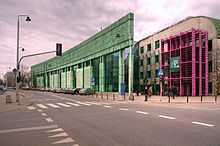Warsaw University Library
| Biblioteka Uniwersytecka w Warszawie | |
|---|---|
| English | Warsaw University Library |
 | |
| Type | University library |
| Established | 1816 |
| Location | Warsaw, Poland |
| Collection | |
| Size | 3,000,000 |
| Other information | |
| Director | Ewa Kobierska-Maciuszko |
| Website | http://www.buw.uw.edu.pl/ |
Warsaw University Library (Polish: Biblioteka Uniwersytecka w Warszawie, BUW) is a library of the University of Warsaw, Poland.
The library was founded in 1816, linguist Samuel Linde became its first director. The library initially housed mostly theological and historical books, the collection was however enlarged by papers from other scientific fields in 1825. In 1831 the library, which served as a public library at that time, already housed 134,000 volumes of books, stored in Kazimierzowski Palace.[1] After the fall of the November Uprising the same year, the institution had been closed, and most of the collection taken away by Russian authorities to Saint Petersburg. In the 1860s the collection numbered 260,000 book volumes.[1] The collection was growing constantly, and a much needed new building was built in 1891-1894 at Krakowskie Przedmieście. Before the outbreak of World War I the collection had grown to 610,000 volumes.[1] During the war some of the most precious books and manuscripts were taken away to Rostov-on-Don by fleeing tsarist authorities. After the 1921 Treaty of Riga, most of the works were returned to Poland. During World War II part of the collection was damaged by fire.
In the 1990s a selection procedure for a new building was initiated. A design by architects Marek Budzyński and Zbigniew Badowski was chosen, and the new library building was opened on 15 December 1999. Six months before, on 11 June 1999, the building was blessed by Pope John Paul II.[2][3]
The distinct new building includes a botanical garden, located on the roof. The garden designed by landscape architect Irena Bajerska, has an area of one hectare, and is one of the largest roof gardens in Europe.[4] It is freely accessible not only to the academia, but also to the public. The main facade on the Dobra Street side contains large blocks of classical texts in various scripts, including the Old Polish text of Jan Kochanowski, Classical Greek text by Plato and Hebrew script from the Book of Ezekiel.
References
- ↑ 1.0 1.1 1.2 Historia 1816-1915 at the official website
- ↑ Wizyta Papieża Jana Pawła II at the official website
- ↑ Piątek, 11 czerwca 1999 - Podsumowanie siódmego dnia pielgrzymki at Mateusz.pl - Christian web service
- ↑ Ogród at the official website
External links
| Wikimedia Commons has media related to University Library in Warsaw. |
Coordinates: 52°14′31.32″N 21°01′29.4″E / 52.2420333°N 21.024833°E